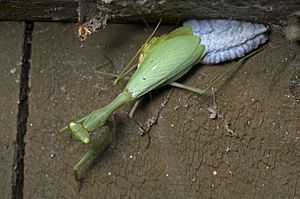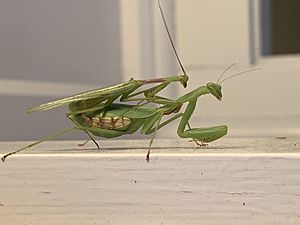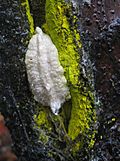Miomantis caffra facts for kids
Quick facts for kids Miomantis caffra |
|
|---|---|
 |
|
| Laying her egg case | |
| Scientific classification |
The Springbok Mantis (its scientific name is Miomantis caffra) is a type of praying mantis. It originally comes from Southern Africa. This insect has also been found in other places like New Zealand (since 1978), Portugal, and Los Angeles, California in North America. It probably traveled to these new places because people traded them as exotic pets.
Female Springbok Mantises have a special ability. They can have babies without needing a male partner. This process is called parthenogenesis. This means a female can lay eggs that hatch into new mantises all by herself!
Contents
About the Springbok Mantis
Egg Cases (Ootheca)
The egg case of the Springbok Mantis is called an ootheca. It is usually 12 to 30 millimeters long. The ootheca has rounded sides and feels soft. Its color can be creamy-brown, fawn, or beige. It also has a small handle-like part at one end.
When the eggs hatch, they do not all hatch at the same time. Baby mantises, called nymphs, can come out over several weeks. Sometimes, they even hatch over two different seasons! If these egg cases are kept cold, like in the exotic pet trade, hatching can be delayed.
These egg cases are very tough. They can survive cold winters. Even in the very cold southern and mountain areas of New Zealand, the eggs can still hatch.
Young Mantises (Nymphs)
Young Springbok Mantises, called nymphs, can be green or brown. Their bodies often have stripes running lengthwise. Their legs might have mottled patterns. The tip of their abdomen usually curves upwards.
Nymphs and almost-adult mantises can have many different colors. Their bodies might be pale yellow, bright green, or reddish-brown. Their legs can range from very light to almost black.
Springbok Mantis nymphs are known to eat each other. This is called cannibalism. They will attack and eat other nymphs, even if there is other food around. They don't mind eating their own brothers and sisters. If two nymphs meet, the bigger one usually eats the smaller one.
Adult Mantises
Adult Springbok Mantises are usually 32 to 60 millimeters long. They are often pale green or brown. Sometimes, they have pink or purple colors near the base of their front wings. Their back wings can be green or bright yellow.
The part of their body behind the head, called the Pronotum, is narrower than their head. It is about one-third of their body length. It is rounded on top and swollen where their legs attach. They also have dark spots on the inside of their front legs.
Male mantises are smaller and thinner than females. They also have longer antennae. If a female mantis is carrying eggs, her abdomen (the back part of her body) will look very big. It will stick out far past her wings.
Behavior of the Springbok Mantis
In its natural home, the Springbok Mantis likes to hide under leaves. When male and female mantises mate, the female sometimes eats the male.
Springbok Mantis in New Zealand
In New Zealand, people often call Miomantis caffra the Springbok Mantis or the South African praying mantis. The first time these mantises were found in New Zealand was in February 1978. An Auckland schoolboy found some nymphs at his home in New Lynn, Auckland.
These nymphs were raised until they became adults. A group of these mantises was then started and kept by the Entomology Division of the DSIR. At first, scientists had trouble figuring out what species they were. They didn't look like any other mantis species from Australia or the Pacific region.
Finally, Dr. A. Kaltenbach from the Naturhistorisches Museum in Vienna identified them. He said they were a common species from Southern Africa, Miomantis caffra. The Springbok Mantis is not seen as a harmful pest. However, scientists think it might be taking over the places where New Zealand's native mantis, Orthodera novaezealandiae, used to live, especially in cities in northern New Zealand.
See also
 In Spanish: Miomantis caffra para niños
In Spanish: Miomantis caffra para niños



